
The Articles of Confederation and Perpetual Union was an agreement among the 13 states of the United States, formerly the Thirteen Colonies, that served as the nation's first frame of government. It was debated by the Second Continental Congress at Independence Hall in Philadelphia between July 1776 and November 1777, and finalized by the Congress on November 15, 1777. It came into force on March 1, 1781, after being ratified by all 13 colonial states. A guiding principle of the Articles was the establishment and preservation of the independence and sovereignty of the states. The Articles consciously established a weak central government, affording it only those powers the former colonies had recognized as belonging to king and parliament. The document provided clearly written rules for how the states' league of friendship, known as the Perpetual Union, would be organized.

The Continental Congress was a series of legislative bodies, with some executive function, for the thirteen colonies of Great Britain in North America, and the newly declared United States before, during, and after the American Revolutionary War. The Continental Congress refers to both the First and Second Congresses of 1774–1781 which, at the time, also described the Congress of the Confederation of 1781–1789, which operated as the first national government until being replaced following ratification of the U.S. Constitution. The Continental Congress represented the 13 colonies and then the new United States from 1774 until 1789. The Congress met predominantly at Independence Hall in Philadelphia, though it was relocated temporarily on several occasions during the Revolutionary War and the fall of Philadelphia.
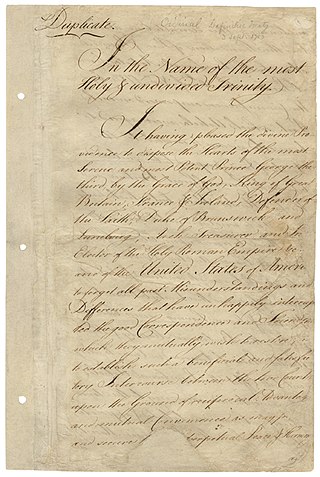
The Treaty of Paris, signed in Paris by representatives of King George III of Great Britain and representatives of the United States on September 3, 1783, officially ended the American Revolutionary War and overall state of conflict between the two countries. The treaty set the boundaries between British North America, later called Canada and the United States, on lines the British labeled as "exceedingly generous". Details included fishing rights and restoration of property and prisoners of war.
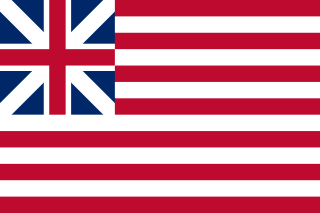
As a result of the American Revolution between 1776 and 1789 thirteen British colonies emerged as a newly independent nation, the United States of America. Fighting in the American Revolutionary War started between colonial militias and the British Army in 1775. The Second Continental Congress issued the Declaration of Independence on July 4, 1776. The Articles of Confederation were ratified in 1781 to form the Congress of the Confederation. Under the leadership of General George Washington, the Continental Army and Navy defeated the British military, securing the independence of the thirteen colonies. The Confederation period continued until 1789, when the states replaced the Articles of Confederation with the Constitution of the United States, which remains the fundamental governing law of the United States.

The United States Constitution has served as the supreme law of the United States since taking effect in 1789. The document was written at the 1787 Philadelphia Convention and was ratified through a series of state conventions held in 1787 and 1788. Since 1789, the Constitution has been amended twenty-seven times; particularly important amendments include the ten amendments of the United States Bill of Rights and the three Reconstruction Amendments.

The Maryland State House is located in Annapolis, Maryland. It is the oldest U.S. state capitol in continuous legislative use, dating to 1772 and houses the Maryland General Assembly, plus the offices of the Governor and Lieutenant Governor. In 1783 and 1784 it served as the capitol building of the United States Congress of the Confederation, and is where Ratification Day, the formal end of the American Revolutionary War, occurred.
Richard Beresford was an American planter and lawyer from Berkeley County, South Carolina. He was a delegate for South Carolina in the Confederation Congress in 1783 and 1784.
Thomas Sim Lee was an American planter, patriot and politician who served as Maryland Governor for five one-year terms, as well as in the Congress of the Confederation (1783-84), Maryland Ratification Convention of 1788 and House of Delegates in 1787. He also held local offices and owned many town lots in Georgetown (which became part of the new federal city, Washington, District of Columbia,and spent his final decades operating "Needwood" plantation in Frederick County, Maryland. In addition to working closely with many of the Founding fathers, he played an important part in the birth of his state and the nation.

The Congress of the Confederation, or the Confederation Congress, formally referred to as the United States in Congress Assembled, was the governing body of the United States from March 1, 1781, until March 3, 1789, during the Confederation period. A unicameral body with legislative and executive function, it was composed of delegates appointed by the legislatures of the several states. Each state delegation had one vote. It was preceded by the Second Continental Congress (1775–1781) and was created by the Articles of Confederation and Perpetual Union in 1781.
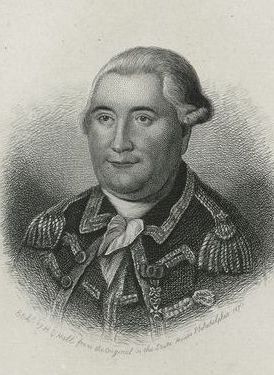
Anne-César de La Luzerne was an 18th-century French soldier and diplomat who had an influential role to the Continental Congress and new government of the United States of America after it gained independence from Great Britain. Descended from an illustrious Normandy family, as a Knight of Malta and the Order of Saint Louis he was styled Chevalier before King Louis XVI created him a Marquis in 1785.

The drafting of the Constitution of the United States began on May 25, 1787, when the Constitutional Convention met for the first time with a quorum at the Pennsylvania State House in Philadelphia, Pennsylvania to revise the Articles of Confederation. It ended on September 17, 1787, the day the Frame of Government drafted by the convention's delegates to replace the Articles was adopted and signed. The ratification process for the Constitution began that day, and ended when the final state, Rhode Island, ratified it on May 29, 1790.

The Perpetual Union is a feature of the Articles of Confederation and Perpetual Union, which established the United States of America as a political entity. Under modern American constitutional law this means that U.S. states are not permitted to withdraw from the Union.

The Confederation period was the era of United States history in the 1780s after the American Revolution and prior to the ratification of the United States Constitution. In 1781, the United States ratified the Articles of Confederation and Perpetual Union and prevailed in the Battle of Yorktown, the last major land battle between British and American Continental forces in the American Revolutionary War. American independence was confirmed with the 1783 signing of the Treaty of Paris. The fledgling United States faced several challenges, many of which stemmed from the lack of a strong national government and unified political culture. The period ended in 1789 following the ratification of the United States Constitution, which established a new, more powerful, national government.
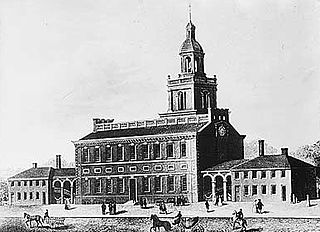
The Pennsylvania Mutiny of 1783 was an anti-government protest by nearly 400 soldiers of the Continental Army in June 1783. The mutiny, and the refusal of the Executive Council of Pennsylvania to stop it, ultimately resulted in Congress of the Confederation vacating Philadelphia and the creation of a federal district, ultimately developed as Washington, D.C., to serve as the national capital.
Diplomacy in the Revolutionary War had an important impact on the Revolution, as the United States evolved an independent foreign policy.
Events from the year 1783 in the United States. The American Revolution officially ended with the Treaty of Paris.
The Treaty of Amity and Commerce Between the United States and Sweden, officially A treaty of Amity and Commerce concluded between His Majesty the King of Sweden and the United States of North America, was a treaty signed on April 3, 1783 in Paris, France between the United States and the Kingdom of Sweden. The treaty officially established commercial relations between these two nations and was signed during the American Revolutionary War.
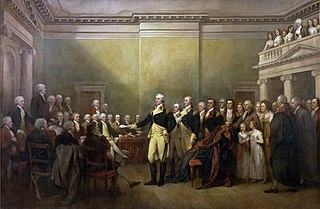
Then Province of Maryland had been a British / English colony since 1632, when Sir George Calvert, first Baron of Baltimore and Lord Baltimore (1579-1632), received a charter and grant from King Charles I of England and first created a haven for English Roman Catholics in the New World, with his son, Cecilius Calvert (1605-1675), the second Lord Baltimore equipping and sending over the first colonists to the Chesapeake Bay region in March 1634. The first signs of rebellion against the mother country occurred in 1765, when the tax collector Zachariah Hood was injured while landing at the second provincial capital of Annapolis docks, arguably the first violent resistance to British taxation in the colonies. After a decade of bitter argument and internal discord, Maryland declared itself a sovereign state in 1776. The province was one of the Thirteen Colonies of British America to declare independence from Great Britain and joined the others in signing a collective Declaration of Independence that summer in the Second Continental Congress in nearby Philadelphia. Samuel Chase, William Paca, Thomas Stone, and Charles Carroll of Carrollton signed on Maryland's behalf.
Admission to the Union is provided by the Admissions Clause of the United States Constitution in Article IV, Section 3, Clause 1, which authorizes the United States Congress to admit new states into the Union beyond the thirteen states that already existed when the Constitution came into effect. The Constitution went into effect on June 21, 1788 in the nine states that had ratified it, and the U.S. federal government began operations under it on March 4, 1789, when it was in effect in 11 out of the 13 states. Since then, 37 states have been admitted into the Union. Each new state has been admitted on an equal footing with those already in existence.












